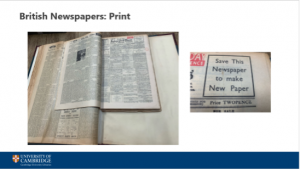In this post, Paul Cooke, History Faculty Librarian at the University of Cambridge, offers some really interesting insights into how he teaches students to engage productively with digital texts in History. Paul can be contacted on Pkc24[at]cam.ac.uk. Find out more about the History Faculty Library here: https://www.hist.cam.ac.uk/seeley-library
Researchers and students at the University of Cambridge are increasingly exposed to digitised historical resources. An online trove of newspapers, official documents and archival material is available to members of the University for use on and off campus. This expansion of content has led to a desire for history students to engage with online resources and make use of the benefits of online and active reading. The Seeley Library (Cambridge’s History Faculty Library) has taken this mission to task and delivered a range of classes to develop the skills of undergraduate students and researchers.
The classes start by introducing students to the concept of a remediated work and how the process of digitisation can affect the documents they read. For example, historical newspapers are normally presented in databases as single articles instead of part of a page of text and images. Students need to be aware of this additional text in order to access surrounding articles which may have an impact on how they interpret and understand what they are reading. This requires a familiarity with the original format and an understanding of what the intended audience would see. This has led to classes showing how historical documents are digitised and discussing the impact of accessing remediated works.

Students at Cambridge have frequently highlighted their frustrations at not being able to use online reading for their research because some platforms restrict them from using their preferred research method. For example, a database of newspapers can be particularly difficult for students conducting a critical discourse analysis or systematic review for their dissertation. Some of these concerns can be overcome by using a reference management tool, such as Zotero (for transcribed works) and Tropy (for archival material). Other students may benefit from being more aware of the tools available on ebook and database platforms, such as tagging, notes and downloading chapter. Through demonstration these functions, library staff are empowering students to proficiently use online resources for a variety of tasks.
There is also a human aspect to reading material online. Most students anticipate being heavily dependent on technology throughout their courses, but the focus on online reading and the increasing development of online collections has led to students spending a lot of time in front of a screen. This is especially true for history students who depend heavily on accessing literature throughout their courses. The Seeley has responded by mentioning wellbeing in all our classes and asking students to consider their welfare when reading online. This includes a recommendation to take regular breaks, adjusting screens for comfort and using assistive technology. For example, we have recommended that students use ambient sound websites as a way to detach themselves from the online environment. We also try to equip students with methods for staying focused while reading online so that they do not distract themselves with social media or news websites.

The advent of online reading has allowed students to read from electronic devices in almost any location. This has had an impact on the social aspects of reading and prevented some students from reading alongside their peers in libraries. As a result, many libraries across Cambridge have introduced virtual reading rooms as a way of allowing students to study together while reading remotely. This was especially useful during the COVID lockdowns, but many of the benefits of this practice can be adapted for future use: for example, the ability for students to discuss their readings in an online environment or for peer-to-peer support in a digital space. It is likely that the lessons learned through helping history students to engage with online learning throughout the pandemic will lead to lasting changes in how librarians support them in future (Shin et al., 2022).
Bibliography
Shin, Nancy, Sally Pine, Carolyn Martin, and Tania Bardyn. “Academic Library Instruction in the Time of a COVID-19 Pandemic – Lessons Learned.” Journal of Web Librarianship 16, no. 1 (January 2, 2022): 1–30. https://doi.org/10.1080/19322909.2021.2015046.